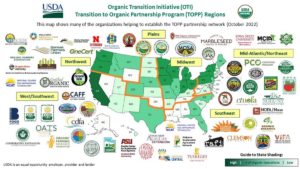Nov 16, 2022
USDA program allocating $300 million to boost organic farming
A federal program designed to support new and existing organic farmers aims to ease a process growers can find daunting and downright “scary,” according to a top U.S. Department of Agriculture official.
 The USDA launched its $300 million Organic Transition Initiative in August of this year. Today, as new details about the program emerged, the International Fresh Produce Association played host to a town hall to discuss the initiative.
The USDA launched its $300 million Organic Transition Initiative in August of this year. Today, as new details about the program emerged, the International Fresh Produce Association played host to a town hall to discuss the initiative.
The online discussion featured Jennifer Tucker, deputy administrator for the USDA Agricultural Marketing Service’s National Organic Program, and George Szczepanski, IFPA director of production, supply chain and environmental policy.
The initiative will include a network of six regional partners in the newly announced Transition to Organic Partnership Program. Also today, California Certified Organic Farmers announced it will serve as the hub for TOPP’s West/Southwest region.
Other TOPP regions include Northwest, Plains, Midwest, Southeast and Mid-Atlantic Northeast. The USDA AMS-built network will be made up of community partners charged with helping provide direct farmer training, education and outreach activities, including mentoring networks, technical assistance and data reporting.
“This is the biggest investment in organic since the foundation of the program, which means that there are no wrong answers right now,” Tucker said during the town hall. “So much of organic is really tacit knowledge. … Sometimes it’s just really nice to be able to talk to somebody.”
Tucker explained the breakdown of the $300 million organic transition investment: $100 million allocated to TOPP; $100 million earmarked for conservation support and crop insurance assistance; and $100 million directed to Pinpoint Market Development, a program designed to build organic supply chains in targeted environments. The third component will consist of $75 million in grants, with a to-be-determined recipient matching component, with the remaining $25 million consisting of commodity procurement, or the government purchasing food.
According to the USDA National Agricultural Statistics Service, the number of noncertified organic farms actively transitioning to organic production dropped by nearly 71% since 2008. While Tucker said some of that decline may be attributable to consolidation, she said it’s a trend the USDA is dedicated to reversing.
“It’s really about anybody who would like to expand organic, either as a new producer in organic or who wants to expand existing acreage or maybe move into different commodities,” she said. “If we’re going to expand the market … we need more growers of all sizes.”
CCOF will serve as the hub for TOPP’s West/Southwest region as part of the organization’s long-standing commitment to organic farming, said Chief Programs Officer Jessy Beckett Parr.
“CCOF has been a leader in organic for nearly 50 years, and we’re proud to serve as a regional hub for this groundbreaking USDA initiative,” Parr said in a news release. “Farmers transitioning to organic will benefit from a unique suite of support as they learn new practices and reimagine their business models.”
The West/Southwest region of the TOPP program includes seven states: California, Utah, Nevada, Arizona, New Mexico, Texas, and Hawaii. CCOF will work with community-based public, private, and nonprofit organizations in these states to help support transitioning and recently transitioned growers.
“The organic community is known for strong local collaboration and providing farmer-to-farmer support,” said Jenny Lester Moffitt, USDA Under Secretary for Marketing and Regulatory Programs. “TOPP will build on this spirit, while bringing organic to new communities of farmers and consumers.”
Tucker said TOPP regions were determined by analyzing data to identify states underrepresented in organic production.
“We will focus state-by-state to determine the needs and interests of the local agricultural community, then encourage organic transition where markets can support this new influx of growers,” Parr said.
CCOF brings a history of supporting transitioning farmers to its TOPP leadership role.
“CCOF has done organic transition work for decades — it’s in our core,” Parr said. “There have been many iterations of this work. For example, in 2020, we worked with Anheuser Busch to conduct internal trainings for their farmers and agronomists and gave away $500,000 in grants, transitioning 100,000 acres.
“We’ll combine our wealth of experience supporting organic transition in our CCOF Foundation programs with the expertise offered by the dozens of organizations participating in the regional network. Organic is, at its core, a community of like-minded farmers, and these regional networks will amplify the work of many partners as they support those transitioning to organic.”
That’s the sort of local/federal partnership the Organic Transition Initiative hopes to facilitate across the country, Tucker said.
“Any successful federal program figures out how to balance centralization and decentralization,” she said. “We’re at the early stages of this, which means anything is possible. We shape it together.”






